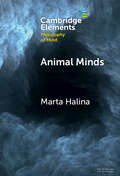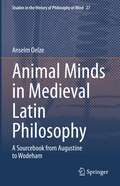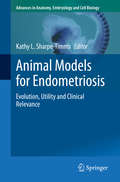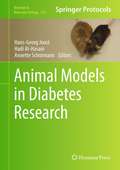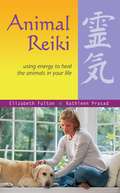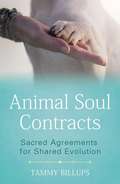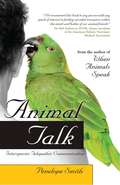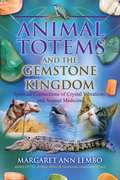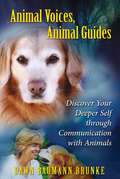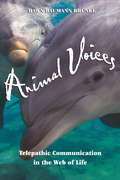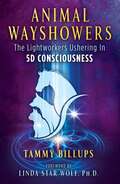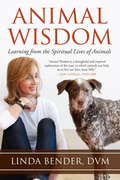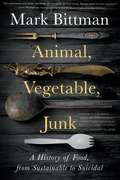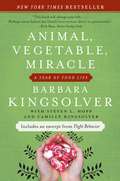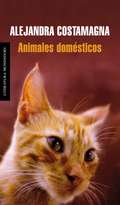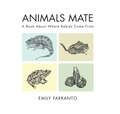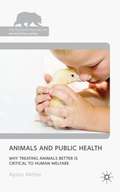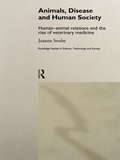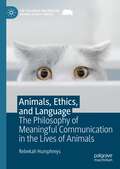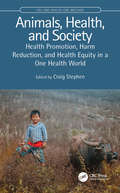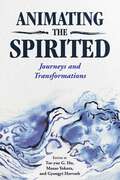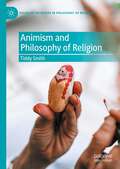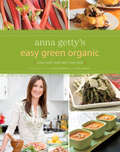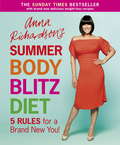- Table View
- List View
Animal Minds (Elements in Philosophy of Mind)
by Marta HalinaAnimal minds are complex and diverse, making them difficult to study. This Element focuses on a question that has received much attention in the field of comparative cognition: 'Do animals reason about unobservable variables like force and mental states?' The Element shows how researchers design studies and gather evidence to address this question. Despite the many virtues of current methods, hypotheses in comparative cognition are often underdetermined by the empirical evidence. Given this, philosophers and scientists have recently called for additional behavioral constraints on theorizing in the field. The Element endorses this proposal (known as 'signature testing'), while also arguing that studies on animal minds would benefit from drawing more heavily on neuroscience and biology.
Animal Minds in Medieval Latin Philosophy: A Sourcebook from Augustine to Wodeham (Studies in the History of Philosophy of Mind #27)
by Anselm OelzeThis sourcebook explores how the Middle Ages dealt with questions related to the mental life of creatures great and small. It makes accessible a wide range of key Latin texts from the fourth to the fourteenth century in fresh English translations. Specialists and non-specialists alike will find many surprising insights in this comprehensive collection of sources on the medieval philosophy of animal minds. The book’s structure follows the distinction between the different aspects of the mental. The author has organized the material in three main parts: cognition, emotions, and volition. Each part contains translations of texts by different medieval thinkers. The philosophers chosen include well-known figures like Augustine, Albert the Great, and Thomas Aquinas. The collection also profiles the work of less studied thinkers like John Blund, (Pseudo-)Peter of Spain, and Peter of Abano. In addition, among those featured are several translated here into English for the first time. Each text comes with a short introduction to the philosopher, the context, and the main arguments of the text plus a section with bibliographical information and recommendations for further reading. A general introduction to the entire volume presents the basic concepts and questions of the philosophy of animal minds and explains how the medieval discussion relates to the contemporary debate. This sourcebook is valuable for anyone interested in the history of philosophy, especially medieval philosophy of mind. It will also appeal to scholars and students from other fields, such as psychology, theology, and cultural studies.
Animal Models for Endometriosis: Evolution, Utility and Clinical Relevance (Advances in Anatomy, Embryology and Cell Biology #232)
by Kathy L. Sharpe-TimmsThis new volume of our successful book series Advances in Anatomy, Embryology and Cell Biology focuses on the need for and use of animal models when studying endometriosis. Covering models ranging from rodents to baboons, it explores novel mechanisms involved in the pathophysiology of endometriosis. Topics range from the role of miRNAs and environmental endocrine disrupters to pain and endometriosis-associated subfertility.Estimated to affect up to 10% of women, endometriosis is a widespread and in some cases debilitating disease. While studies on the pathophysiology of the disease and the development of treatments for endometriosis-associated subfertility are called for, acquiring appropriate tissues from women with and without endometriosis in combination with physiologically relevant in vitro and in vivo laboratory models is an essential aspect. However, control subjects with similar ages, living environments and medical histories, besides endometriosis, are hard to find and attaining suitable human reproductive tissues is linked to an ongoing ethical discussion, especially when studying embryos. Laboratory models like rodent and monkey models are therefore needed to fill the research gap and support hypothesis-driven, randomized, controlled experimental design studies. In this book we highlight the latest developments and findings in endometriosis research using animal models. The book was written for scientists, physicians and medical students working in the field of reproductive science, and for women with endometriosis.
Animal Models in Diabetes Research (Methods in Molecular Biology #933)
by Hadi Al-Hasani Annette Schürmann Hans-Georg JoostIn recent years, human studies have made enormous contributions towards an understanding of the genetic basis of diabetes mellitus; however, most of the experimentation needed for the invention and testing of novel therapeutic approaches cannot be performed in humans. Thus, there is no alternative to appropriate animal models. In Animal Models in Diabetes Research, expert researchers explore the current status of the most important models and procedures in order to provide a timely resource in experimental diabetology. The first half of the volume serves as a comprehensive overview on our current knowledge of the pathogenesis and pathophysiology of diabetes in animal models through a series of reviews in model strains. The book then continues with vital, established protocols that are employed in the characterization and study of animal models of diabetes. As a volume in the highly successful Methods in Molecular BiologyTM series, this work contains the type of detailed description and key implementation advice necessary to achieve successful results. Authoritative and cutting-edge, Animal Models in Diabetes Research delivers essential content that will be an important resource to advance diabetes research in the years to come.
Animal Reiki: Using Energy to Heal the Animals in Your Life (Travelers' Tales Guides)
by Elizabeth Fulton Kathleen Prasad“A great introduction to the growing field of energy medicine. . . . Easy-to-read . . . this book will be enjoyed by animal guardians and veterinarians alike.” —Shawn Messonnier, DVM, author of The Natural Health Bible for Dogs & CatsWhether you’re a newcomer to the field of energy healing, an experienced practitioner or an animal lover committed to learning everything you can about your companion’s health, Animal Reiki will open your eyes to a new level of health and well-being. From dogs and cats to horses and birds, this book is everything you need to understand and appreciate the power of Reiki to heal and deepen the bond with the animals in your life.“I learned a lot from Animal Reiki and highly recommend it to a wide audience.” —Marc Bekoff, University of Colorado, author of Minding Animals and editor of the Encyclopedia of Animal Behavior“Fulton and Prasad have created a much-needed guide to a method of helping animals heal that is gentle, intuitive, safe and powerful.” —Susan Chernak McElroy, author of All My Relations: Living with Animals as Teachers and Healers“A powerful reminder of the wider uses of the system of Reiki and how humanity can be of purposeful benefit to all.” —Bronwen and Frans Stiene, International House of Reiki, authors of A-Z of Reiki, The Japanese Art of Reiki and The Reiki Sourcebook
Animal Soul Contracts: Sacred Agreements for Shared Evolution
by Tammy BillupsA guide to discovering the spiritual agreements between our souls and those of our animal companions • Explains how animals have physical or behavioral issues to evolve their souls as well as help our soul&’s evolution and release past-life karma • Describes what happens energetically and spiritually with animals in the weeks before they transition and during their passing • Includes practical instructions for identifying the different types of animal soul contracts and aligning with them to assist your shared evolutionary journey Animal lovers are extraordinary. Despite awareness that we will probably outlive our beloved pets, we are still drawn, time and time again, to the connection, joy, and unconditional love that come with sharing our lives, homes, and laps with animals. Many of us feel something deeper than just companionship with our animal friends--a heart-to-heart connection felt all the way to the soul level. Revealing the higher purpose and soul mission behind our relationships with our animal companions, Tammy Billups explores the spiritual contracts that are created when a human bonds with an animal and shows how we come into each other&’s lives for a reason. Providing real-life examples, Billups explains why animals choose, at the soul level, to have certain perceived negative experiences, such as physical or behavioral issues, to evolve their souls, clear karma, and help our soul&’s evolution. She shows that human and animal souls orchestrate every experience and interaction that holds potential for transformation and healing, including the final transition. She demonstrates the inner dynamics of the animal-human relationship to help animal lovers understand their soul contracts with their pets. The inspirational, real-life examples of animal-human tandem healings that Billups facilitated identify the soul contracts within each pairing that transformed feelings of grief, loss, abandonment, betrayal, trauma, abuse, and anxiety. The author reveals how animals we have previously loved and shared our lives with come back, either on the spirit level or reincarnated in a new animal form, to support us. Offering peace and hope to those who&’ve lost beloved animal companions, she describes what she&’s witnessed during healing sessions with animals in the weeks before they transition and during their passing. Billups also includes practical instructions for identifying different types of animal soul contracts and connecting with and enlisting the help of your light team or spirit guides. By discovering the soul agreements that underlie our animal partnerships, we can find meaning in the issues that arise with our animals and ourselves, support our souls&’ mutual evolution, and allow the soul contracts to weave their spiritual magic in the animal-human relationship.
Animal Talk
by Penelope SmithThree decades ago, Penelope Smith fi rst presented Animal Talk and her effective telepathic communication techniques that can dramatically transform your relationships with your animal companions. Rereleased by popular demand, Smith once again shares her insightful wisdom and illuminates topics such as freedom, control, obedience, behavior, and relationships between animals. Animal Talk teaches you how to open the door to your animal friends' hearts and minds without resorting to magic tricks or wishful thinking. Every creature can be reached through telepathic communication -- from your tabby cat or cockatiel to the wasps that build nests in the eaves of your home or even the common flea -- you just have to be open to the idea, and mind-to-mind communication will be in your grasp.
Animal Totems and the Gemstone Kingdom: Spiritual Connections of Crystal Vibrations and Animal Medicine
by Margaret Ann LemboShares the wisdom of animals and their matching gemstones to help work on yourself mentally, emotionally, physically, and spiritually • Reveals the energetic connections between 88 different animal allies and 88 gems, stones, and crystals from the mineral kingdom • Includes animal medicine teachings from a variety of creatures, from hummingbirds and cats to dolphins and bears, to help you find inner peace, knowledge, and wisdom • Explains how the color, formation, and the manner in which a stone grows in the Earth offers a teaching to know yourself and your life purpose All creatures, great and small, in all species on this planet are interconnected. When an animal, insect, bird, or other creature from nature appears repetitively, whether in real life or dreams, it is time to pay attention and find the message that nature is bringing you. There are many teachings available to us through the observation of a particular animal totem and their habits and patterns. For example, parrot medicine can teach us to see life from another perspective as we mimic the wise ones who have walked on the path before us. Mouse medicine teaches us to scrutinize all the details before taking action. Bear may teach you to go within yourself to find answers within your personal cave. Every animal is an ally, and every animal has a story to help you find inner peace, knowledge, and wisdom. The associated gemstone for each animal totem is a further indication of the energy of the animal as symbolism and a teaching on your sacred journey. Crystals, minerals, and stones hold the history of the Earth and all this planet has to offer you to evolve your soul and spirit in this incarnation. The color, formation, and the manner in which the stone grows in the Earth offers a teaching to know yourself and your life purpose. It takes time and inner reflection to understand the messages and clues throughout the gemstone kingdom. Matching the teachings of animals with the teachings of gemstones, Margaret Ann Lembo shows how there is symbolism in all around offering clues to light your path. Exploring 88 gems, stones, and crystals and 88 different animal allies, she details the spiritual connections of crystal vibrations and animal medicine, providing you with a deeper understanding of the interconnected energies of everything around us. She shows how the spiritual fulfillment you seek is available to you in so many ways and this path of working with gemstones and animal medicine is just one of many.
Animal Voices, Animal Guides: Discover Your Deeper Self through Communication with Animals
by Dawn Baumann BrunkeHow to connect with animal guides to expand individual and planetary awareness • Reveals techniques for exploring dreams, shamanic journeys, healing, and shapeshifting with animals • Presents words of wisdom from cats, dogs, horses, llamas, rabbits, ravens, bears, and even insects As companions, helpers, and spiritual guides, animals have always held a special relationship with humans. As we access our natural ability to communicate with animals, we cannot help but open ourselves more profoundly to life, other human beings, and our own deep nature--the essence of who we really are. Animal Voices, Animal Guides presents a wide variety of ways in which we can tune in to the “universal language” of all life and reconnect with the animal kingdom in more conscious, meaningful ways. Through myths, shamanic journeys, and dreams we meet our power animals, spirit animals, and wise animal guides. The exercises, meditations, stories, and experiments included are designed to help us tune in to the subtle whispers of nature and expand our awareness. We learn what sled dogs have to teach us about teamwork, how llamas see themselves as healers of the world, and how it would feel to inhabit the skin of a shark. Filled with advice from animal communication professionals and actual conversations with animals, Animal Voices, Animal Guides is an invitation to explore our inner ways of knowing. When we learn how to use all our senses to listen to animals, we will find out how to listen to our authentic self as well.
Animal Voices: Telepathic Communication in the Web of Life
by Dawn Baumann BrunkeAnimals ranging from mosquitoes to elephants use their own words to guide humanity to a deeper spiritual awakening. • Contains interviews with 25 professional animal communicators and over 100 different animals and animal spirits. • Provides a thrilling glimpse of the possibilities of direct animal-human dialogue. According to Echo, an Arabian mare, "Humans are beings of love who have forgotten what love is and who they are." Along with a host of other animal communicators, Dawn Baumann Brunke gives animals like Echo a voice--a direct line of communication to the human mind. Through Animal Voices, the animal kingdom delivers a message about deepening our spirituality and reconnecting with the web of life. Our earliest ancestors had an ongoing shamanic dialogue with the animal kingdom, but this ability has been lost to most in the modern world. Brunke provides the techniques to reopen these connections, reminding us that when we are open to communication with animals, we are open to deeper layers of ourselves. The main contributors to this book are actual animals, who reveal themselves to be sentient beings with their own thoughts, emotions, and spiritual reasons for being on the planet. How Brunke overcame her initial skepticism and learned to hear their voices is a fascinating story. Throughout Animal Voices the author integrates her own reflections with those of the animals she interviews. The result is something that will delight animal lovers and force skeptics to reconsider their ideas about the nature of animal consciousness and the possibility of telepathic human-animal communication.
Animal Wayshowers: The Lightworkers Ushering In 5D Consciousness
by Tammy Billups• Explains how animals that live alongside humans are lightworkers helping to raise the vibration of collective consciousness and aid in humanity&’s ascension process• Shares example stories of incredible animal Wayshowers from around the world whose actions and sacrifices on behalf of their human companions changed them all for the better• Offers meditations, rituals, and transformational soul practices to embrace 5D frequencies, intuit heart intelligence, connect to the Higher Self, and heal the shadowAnimals are natural holders of 5D consciousness. The extraordinary animals who have chosen, at a soul level, to live alongside humans are lightworkers on the front lines of the animal kingdom&’s mission to help people to heal, evolve, and assist in raising the vibration of the planet and collective consciousness to 5D.As Tammy Billups reveals, once we become aware of the soul path of our animal companions, we are then able to connect with them soul-to-soul, not only supporting their soul missions but also finding the healing we need to let go of 3D reality. Sharing stories of incredible animal wayshowers from around the world, she explores the many levels of service your beloved animal friends are providing you every day, including during disasters, storms, and pandemics. She shows how they help shoulder the psychological and emotional burdens we are not yet capable of holding on our own and show us the way back to our own hearts. The author offers meditations, rituals, and exercises for applying the teachings of the animal stories shared, including transformational soul practices to embrace 5D frequencies, intuit heart intelligence, connect to the Higher Self, and heal the shadow. Offering ways to embrace and emulate the soul teachings of our animal companions, Tammy Billups shows that, by honoring animals as courageous guides on our ascension to 5D consciousness, we too can become wayshowers in our own right
Animal Wisdom
by Andrew Harvey Linda Tucker Linda BenderHow is it that pets are able to travel thousands of miles through unknown territory to reunite with their beloved humans? How can dogs detect cancer with up to a 98 percent accuracy rate, and foresee epileptic or diabetic seizures in their owners? How do animals seem to know an earthquake is coming long before the world's best seismologists? In Animal Wisdom, veterinarian and animal advocate Linda Bender offers a wealth of amazing stories and research-based evidence indicating animals have deeply perceptive--even extrasensory--abilities. She shows us that animals are extremely perceptive, intuitive, and psychic and provides step-by-step practices for honing your natural ability to communicate with them, so that you too can learn to understand their urgent messages about peace, happiness, and the future of the planet. Animal Wisdom is for animal lovers and anyone who seeks a deeper, more spiritual connection to these beautiful creatures.From the table of contents:Foreword by Linda TuckerPART I: The Fabric of CreationChapter 1: The Ecology of ParadiseChapter 2: How Can We Know What Animals Are Thinking and Feeling?PART II: What Animals Want Us to KnowChapter 3: You Are LovedChapter 4: You Are Already Living in ParadiseChapter 5: You Don't Have to Figure Everything OutChapter 6: Dying Isn't BadPART III: The Connection of All CreaturesChapter 7: How to Connect Telepathically with Animals: A Practical GuideChapter 8: The Animals Speak for ThemselvesChapter 9: Heeding the Cries of the Nonhuman WorldAfterword by Andrew HarveyFrom the Trade Paperback edition.
Animal, Vegetable, Junk: A History of Food, from Sustainable to Suicidal
by Mark BittmanFrom hunting and gathering to GMOs and ultraprocessed foods, this expansive tour of human history rewrites the story of our species—and points the way to a better future.The history of Homo sapiens is usually told as a story of technology or economics. But there is a more fundamental driver: food. How we hunted and gathered explains our emergence as a new species and our earliest technology; our first food systems, from fire to agriculture, tell where we settled and how civilizations expanded. The quest for food for growing populations drove exploration, colonialism, slavery, even capitalism. A century ago, food was industrialized. Since then, new styles of agriculture and food production have written a new chapter of human history, one that&’s driving both climate change and global health crises. Best-selling food authority Mark Bittman offers a panoramic view of the story and explains how we can rescue ourselves from the modern wrong turn.
Animal, Vegetable, Miracle: A Year of Food Life
by Barbara Kingsolver Steven L. Hopp Camille KingsolverBestselling author Barbara Kingsolver returns with her first nonfiction narrative that will open your eyes in a hundred new ways to an old truth: You are what you eat. "As the U.S. population made an unprecedented mad dash for the Sun Belt, one carload of us paddled against the tide, heading for the Promised Land where water falls from the sky and green stuff grows all around. We were about to begin the adventure of realigning our lives with our food chain. "Naturally, our first stop was to buy junk food and fossil fuel. . . ." Hang on for the ride: With characteristic poetry and pluck, Barbara Kingsolver and her family sweep readers along on their journey away from the industrial-food pipeline to a rural life in which they vow to buy only food raised in their own neighborhood, grow it themselves, or learn to live without it. Their good-humored search yields surprising discoveries about turkey sex life and overly zealous zucchini plants, en route to a food culture that's better for the neighborhood and also better on the table. Part memoir, part journalistic investigation, Animal, Vegetable, Miracle makes a passionate case for putting the kitchen back at the center of family life and diversified farms at the center of the American diet. "This is the story of a year in which we made every attempt to feed ourselves animals and vegetables whose provenance we really knew . . . and of how our family was changed by our first year of deliberately eating food produced from the same place where we worked, went to school, loved our neighbors, drank the water, and breathed the air."
Animales domésticos
by Alejandra CostamagnaComo silenciosos espectadores de las vicisitudes de la vida cotidiana aparecen los animales domésticos que pueblan este magnífico conjunto de relatos. Se asoman para observar cómo a su alrededor las parejas, las familias, padres e hijos se relacionan ante hechos que los ponen a un paso de la felicidad o la desdicha. Una mujer tiene que decidir si se opera de una enfermedad grave o en definitiva no lo hace. Una pareja en crisis acude de madrugada a una clínica para salvar a un gato. Un hombre solitario encuentra a un perro y no está seguro de si desea devolverlo. Una amante persigue a quien la ha abandonado hasta el otro lado del mundo?Con delicadeza, como si dibujara sobre un papel transparente, Alejandra Costamagna perfila mundos donde el lector se acercará a la extrañeza y la fugacidad de la vida.
Animals Mate: A Book About Where Babies Come From
by Emily Farranto"Where do babies come from?" It's a question every child asks eventually, and Animals Mate is the simple, straightforward, and developmentally appropriate guide every parent needs to normalize sexual reproduction via adorable animal partners. With a modern design and beautiful illustrations, Animals Mate introduces facts about mating, including tactful discussion of the mechanics of the process, anatomy, and sperm and eggs. Bypass the awkwardness that often accompanies "the talk" about how babies are made and help your child understand sex and reproduction as the natural and wonderful process that results in the world's greatest treasure: babies!
Animals and Public Health
by Aysha AkhtarA compelling argument of how human health is adversely affected by our poor treatment of non-human animals. The author contents that in order to successfully confront the 21st Century's health challenges, we need to broaden the definition of the word 'public' in public health to include non-human animals.
Animals, Disease and Human Society: Human-animal Relations and the Rise of Veterinary Medicine (Routledge Studies in Science, Technology and Society #No.2)
by Joanna SwabeThis book explores the history and nature of our dependency on other animals and the implications of this for human and animal health. Writing from an historical and sociological perspective, Joanna Swabe's work discusses such issues as:* animal domestication* the consequences of human exploitation of other animals, including links between human and animal disease* the rise of a veterinary regime, designed to protect humans and animals alike* implications of intensive farming practices, pet-keeping and recent biotechnological developments.This account spans a period of some ten thousand years, and raises important questions about the increasing intensification of animal use for both animal and human health.
Animals, Ethics, and Language: The Philosophy of Meaningful Communication in the Lives of Animals (The Palgrave Macmillan Animal Ethics Series)
by Rebekah HumphreysWith an ever-growing body of evidence on the links between different oppressions, never have the debates in Critical Animal Studies surrounding intersectionality in relation to animal ethics been more important. In particular, the arguments related to anthropomorphic attributes of mentality to other than humans promise to provide fruitful new ground for re-assessing human-animal relations. This book maps the central debates surrounding anthropomorphism in relation to our descriptions of animals, their lives, animal mentality, and meaningful communication in the nonhuman world. Rebekah Humphreys synthesizes the work of critical animal theorists, philosophers, and cognitive ethologists, and provides a critical account of how the debates concerning anthropomorphism play a key role in a proper understanding of animal ethics.
Animals, Health, and Society: Health Promotion, Harm Reduction, and Health Equity in a One Health World (CRC One Health One Welfare)
by Craig StephenThis timely book reframes the historic narrative of people, animals, and nature as risks to each other, to one where we think about health as a shared capacity. This new narrative promotes the positive contributions made to health across species and generations and addresses growing calls to shift from a reactive to proactive approach in One Health. Editor Craig Stephen takes the reader on a tour of the situations wherein we can all, regardless of our job description, work across species, sectors, and generations to motivate action. Perspectives and methods from a variety of fields and experts are shared and adapted to promote collaborative understanding of and action on determinants of health at the animal-society interface. Case studies demonstrate that the principles and practices presented are feasible, empowering people to make choices that concurrently benefit the health of animals, societies, and ecosystems. The first book to adapt and explain health promotion, harm reduction, and health equity issues in a One Health context, and in terms of animal health, this is necessary reading for students of and practitioners working in planetary health, conservation, ecohealth, public health, health promotion, veterinary medicine, and animal welfare.
Animating the Spirited: Journeys and Transformations
by Tze-yue G. Hu, Masao Yokota and Gyongyi HorvathContributions by Graham Barton, Raz Greenberg, Gyongyi Horvath, Birgitta Hosea, Tze-yue G. Hu, Yin Ker, M. Javad Khajavi, Richard J. Leskosky, Yuk Lan Ng, Giryung Park, Eileen Anastasia Reynolds, Akiko Sugawa-Shimada, Koji Yamamura, Masao Yokota, and Millie Young Getting in touch with a spiritual side is a craving many are unable to express or voice, but readers and viewers seek out this desired connection to something greater through animation, cinema, anime, and art. Animating the Spirited: Journeys and Transformations includes a range of explorations of the meanings of the spirited and spiritual in the diverse, dynamic, and polarized creative environment of the twenty-first century. While animation is at the heart of the book, such related subjects as fine art, comics, children's literature, folklore, religion, and philosophy enrich the discoveries. These interdisciplinary discussions range from theory to practice, within the framework of an ever-changing media landscape. Working on different continents and coming from varying cultural backgrounds, these diverse scholars, artists, curators, and educators demonstrate the insights of the spirited. Authors also size up new dimensions of mental health and related expressions of human living and interactions. While the book recognizes and acknowledges the particularities of the spirited across cultures, it also highlights its universality, demonstrating how it is being studied, researched, comprehended, expressed, and consumed in various parts of the world.
Animism and Philosophy of Religion (Palgrave Frontiers in Philosophy of Religion)
by Tiddy SmithMainstream philosophy of religion has persistently failed to engage seriously or critically with animist beliefs and practices. The field that is now called "philosophy of religion" could quite easily be renamed "philosophy of theism" with few lecturers on the subject having to change their lecture notes. It is the aim of this volume to rectify that failure and to present animism as a live option among the plethora of religious worldviews. The volume addresses four major questions: 1. What is this thing called "animism"? 2. Are there any arguments for or against animist belief and practice? 3. What is the relationship between animism, naturalism, and the sciences? And 4. Should we take animism seriously? Animism and Philosophy of Religion is intended to be the first authoritative scholarly volume on the issue of animism and its place in the philosophy of religion. Ambitiously, it aims to act as the cornerstone volume for future work on the subject and as a key text for courses engaging with the subject.
Anna Getty's Easy Green Organic
by Anna GettyIn this fact-filled guide and cookbook, the chef and organic living expert shares essential tips and recipes for a delicious, healthy, eco-friendly diet.Anna Getty loves great food made from fresh, organic, and sustainably harvested ingredients. In Anna Getty Easy Green Organic, Anna explains how to shop for organic, seasonal, and local ingredients, how to keep an eco-friendly kitchen, and how to cook meals that are as scrumptious to eat as they are healthy for you and the earth. Such delights as Roasted Tomato and Goat Cheese Toasts, Double Lemon Chicken Breast with Fresh Tomato Basil Salsa, and Mini-Strawberry Rhubarb Crumbles are a mouthwatering way to achieve a healthier, organic lifestyle. Packed with sound advice, plenty of color photographs, and one hundred fabulous recipes, Anna Getty Easy Green Organic is the is a must-read for the discerning home cook.
Anna Richardson's Summer Body Blitz Diet: Five Rules for a Brand New You
by Anna RichardsonA brand new you is just around the corner!10 new recipes in this updated edition of Anna Richardson's BODY BLITZ. Get ready for summer!Anna Richardson was a self-confessed serial dieter. You name it, she tried the diet. And failed. Perhaps there was some weight loss to begin with but the pounds would always creep back on, and maybe a few more besides. And then something incredible happened. Anna discovered the simple secret to sustained weight loss. Using five food rules she lost two stone and kept the pounds and inches off. ANNA RICHARDSON'S BODY BLITZ DIET is Anna's easy-to-follow plan that guarantees up to 7lbs weight loss in fourteen days. This new edition of her best selling diet book includes 10 brand new summer recipes. Follow the SUMMER BODY BLITZ DIET and you'll get your confidence - and waistline - back for good.
Anna Richardson's Summer Body Blitz Diet: Five Rules for a Brand New You
by Anna RichardsonA brand new you is just around the corner!10 new recipes in this updated edition of Anna Richardson's BODY BLITZ. Get ready for summer!Anna Richardson was a self-confessed serial dieter. You name it, she tried the diet. And failed. Perhaps there was some weight loss to begin with but the pounds would always creep back on, and maybe a few more besides. And then something incredible happened. Anna discovered the simple secret to sustained weight loss. Using five food rules she lost two stone and kept the pounds and inches off. ANNA RICHARDSON'S BODY BLITZ DIET is Anna's easy-to-follow plan that guarantees up to 7lbs weight loss in fourteen days. This new edition of her best selling diet book includes 10 brand new summer recipes. Follow the SUMMER BODY BLITZ DIET and you'll get your confidence - and waistline - back for good.
